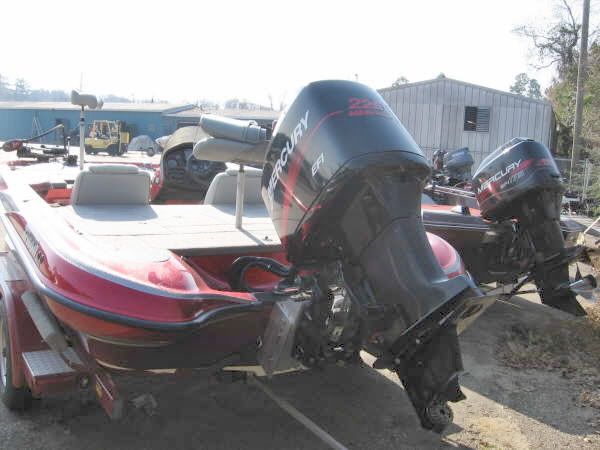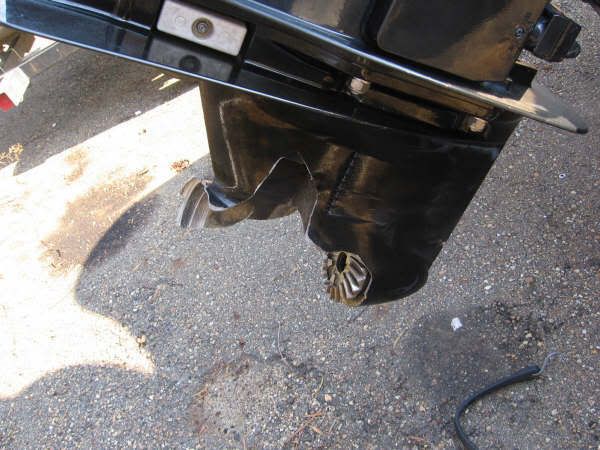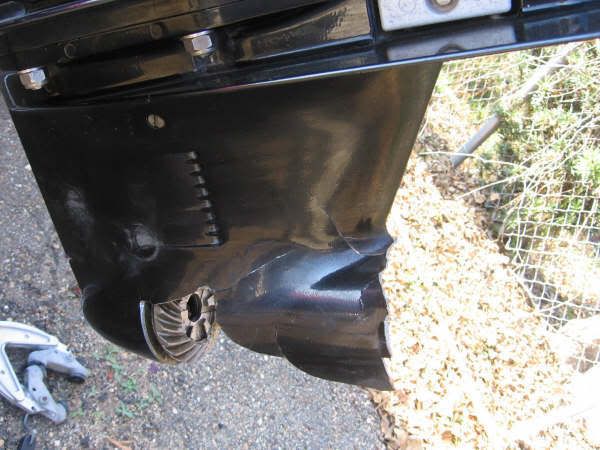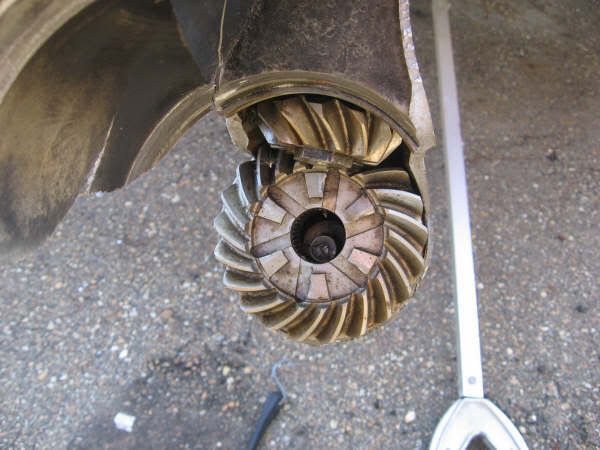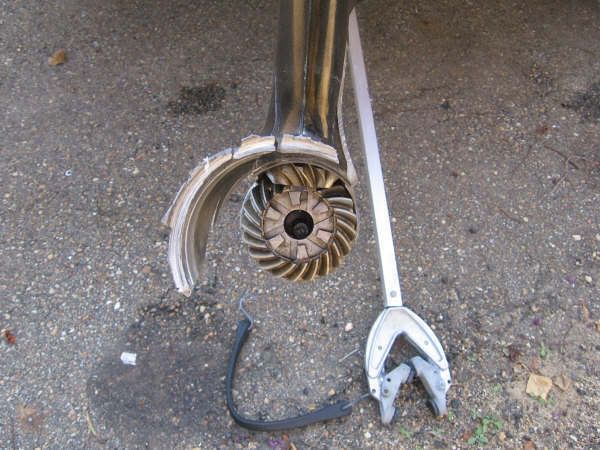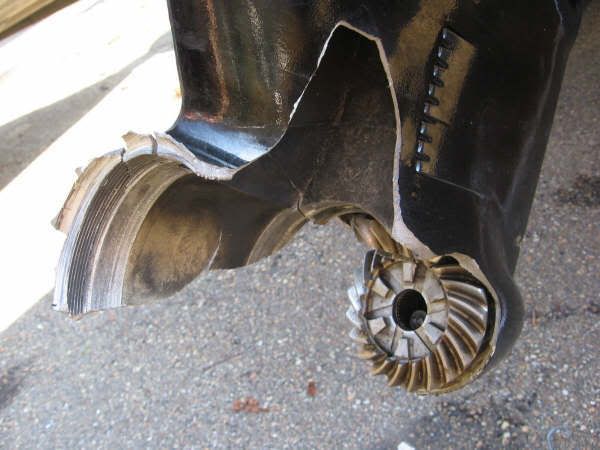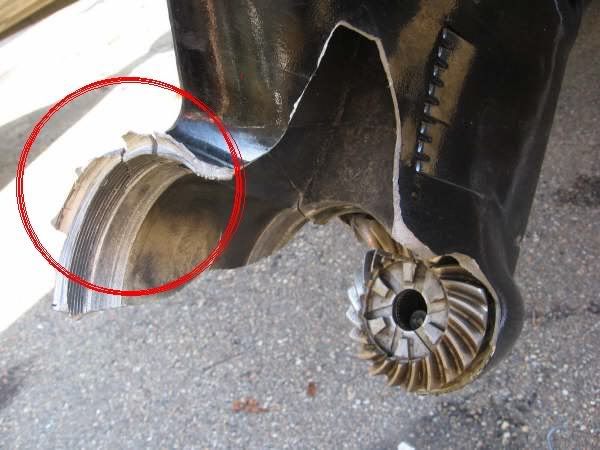Re: Need Some Opinions
If a trailering problem, I think you would just grind your way up from the bottom; skeg and prop together; prop in either 3 or 4 blades would just sit there and grind away.
The only way this could happen if trailering caused, would be for there to be a bump; a very big, hard, bump, like the trailer hit a really big chuckhole on a really hard road, (concrete); but it would not explain the wearing away of the rear of the gearcase where the threads are......the prop had to be turning and turning a lot to do that and that aint-a-gonna-happen trailering. So forget that.
----------------
At 65 mph a tree top might seem like a concrete bridge railing. Even in deep water, tree tops exist; but to do this? Naw! Would have to be a concrete bridge/bridge railing which do exist when they flood lakes and don't take out old bridges. Lake Ray Hubbard in Dallas is a perfect example. BTDT
The fact that the front of the gearbox is intact suggests to me the skeg hit something below the gearbox frontal area.
I think if this were throwing parts (internal to the gearbox), it would blow out the side of the housing as a hole. The fact that the visable gears are clean tells me that it wasn't foreign object damage in the geartrain. Besides there aren't any parts in that area other than maybe the pin that holds the shift dog to the propshaft; that has a big spring around it to keep it in place and this is a new engine. So I doubt that to be the problem either.
----------------------------
The housing broke from underneath and the break started up just behind the reinforced nosecone. If you blew out from the rear, the tears wouldn't be where they are.......
which rules out the last thing I am going to say and that is that the thrust washer wasn't installed.The stress of the impact literally pulled the aluminum molecules apart like happens (you can observe) when you take aluminum and bend it back and forth a few times the way it just breaks apart.
The stress of the strike was pushing against the skeg and if you'll notice both sides of the gearhousing started splitting symmetrically upwards. Just so happens that the starboard side was slightly weaker and yielded first, or the boat was in a turn, giving the shape of the housing break.
-------------
Some things that don't make sense.
The prop was probably the standard right hand rotation like the prop on the other boat in the first picture.
That says that the force from it would be to port and down. The marks on the rear of the housing immediately behind the threads indicate that type of force.
So I'd expect the port side of the housing to be blown out, not the starboard.
The other thing is how'd the prop get to the housing to score it up in the first place? The front of the propshaft sticks into the rear of F gear which is still intact. The propshaft movement is maybe .100 inch fore-aft, max. normally.
For the prop to hit the left side the shaft would have to move to the left as would R gear and the gimbal bearing supporting it. That would breakout the port side of the housing which is cracked, but still intact; unlike the right side which is blown away.
If, in fact the thrust washer were not installed, the prop could gnaw it's way up the propshaft eating away at the casting but making one terrible noise that might or might not go unnoticed. I'd think this would be obvious, along with a significant power reduction, vibration of the engine, when the boat first punched out upon leaving the ramp. Maybe even idling thru the "no wake zone" would have given indications that something's amiss and start an investigation (by the operator) as to why.
But that could have happened and as the rear of the gearbox was being removed, the prop shaft was able to start wobbling which would account for the expansion (pushed out) part of the port side.
Then either it was just a matter of one side beating the other in falling off, or something as simple as the engine being turned to the right, in a right turn to generate enough impalance of the pressure on the propshaft for it to be able to come out of the forward gear and the whole thing blow away.
------------------
So for a forward strike I would look for gouge marks under the nose of the gearbox where the skeg is attached; may or may not be any evidence depending upon how low the strike was. I have hit objects (concrete) on the skeg and the skeg would just shear away but never had one hit near the top where the skeg interfaces with the gearhousing. Up there, especially at 60 mph where things happen fast, the skeg might not have time to shear before the impact stress was transferred to the housing.
For a missing thrust washer, a real long shot as the operator should have suspected something before you got to this kind of damage, I'd look for gouges around the hole in the F gear where the nose of the propshaft mounts caused by the prop shaft ripping out the side of the gearhousing. (The teeth are hardened but I don't think the whole gear is treated, just the teeth.)
But if this were the case, especially since the prop is pushing on the propshaft because the splines are still there and one would suppose the hub were still intact to the prop, you'd think the F gear would have been ripped out also; i.e. the housing would be broken there too.
Really good material for a good "Mickey Spillane Mystery Novel.
I know where this is headed. Insurance claim, or warranty repair.

--------------------------------------------------------
Well, after looking, reading, and writing for an hour, I'm going for a frontal strike of a solid object while at high speed in the water.
--------------------------------------------------------
Wish you luck.
Mark






















